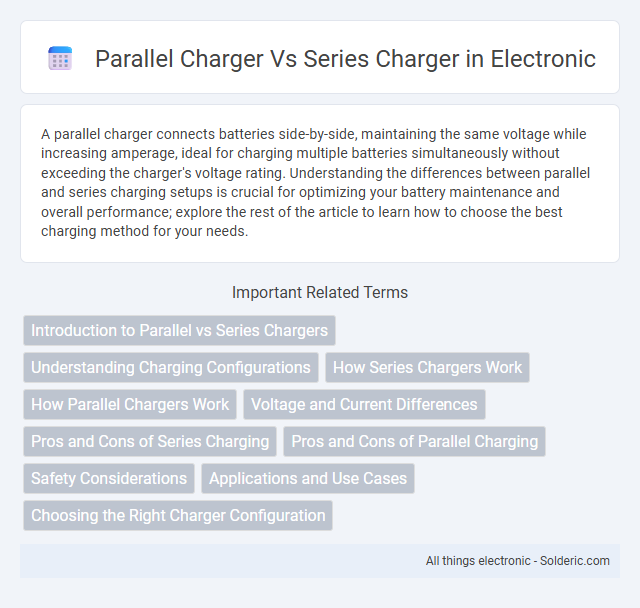A parallel charger connects batteries side-by-side, maintaining the same voltage while increasing amperage, ideal for charging multiple batteries simultaneously without exceeding the charger's voltage rating. Understanding the differences between parallel and series charging setups is crucial for optimizing your battery maintenance and overall performance; explore the rest of the article to learn how to choose the best charging method for your needs.
Comparison Table
| Feature | Parallel Charger | Series Charger |
|---|---|---|
| Connection Type | Batteries connected in parallel | Batteries connected in series |
| Voltage Output | Same as single battery voltage | Sum of all battery voltages |
| Current Output | Increased total current capacity | Same as single battery current rating |
| Charging Time | Faster charging due to higher current | Longer charging due to higher voltage |
| Risk of Overcharging | Lower risk, easier to balance cells | Higher risk, requires careful voltage management |
| Use Case | Applications needing stable voltage with higher capacity | Applications requiring higher voltage output |
Introduction to Parallel vs Series Chargers
Parallel chargers connect batteries by linking positive terminals together and negative terminals together, enabling the charging of multiple batteries simultaneously at the same voltage but increasing the overall current. Series chargers connect batteries end-to-end, combining voltages while maintaining the same current, which is ideal for charging higher voltage battery packs. Understanding the difference between parallel and series chargers helps you select the right charging method for your battery configuration and power requirements.
Understanding Charging Configurations
Parallel chargers maintain the same voltage across all battery cells while increasing the total current, enabling faster charging without exceeding individual cell voltage limits. Series chargers, on the other hand, increase the voltage by connecting cells end-to-end, ensuring balanced charging but requiring careful voltage regulation to prevent overcharging. Understanding these charging configurations helps you select the right method for your battery type and charging efficiency.
How Series Chargers Work
Series chargers work by connecting multiple batteries end-to-end, allowing the electrical current to flow through each battery in a single path, which increases the total voltage output while maintaining the same current. This setup ensures that the charging voltage is divided proportionally across all batteries, making it suitable for applications requiring higher voltage. Your device benefits from consistent voltage levels, but the overall current remains the same as a single battery in the chain.
How Parallel Chargers Work
Parallel chargers connect multiple batteries by linking their positive terminals together and their negative terminals together, allowing each battery to be charged simultaneously at the same voltage level. This setup ensures that the voltage applied to all batteries remains constant while the charging current divides among them based on each battery's state of charge and capacity. Parallel charging is ideal for batteries of the same voltage rating, as it maintains uniform voltage while increasing total available capacity and charging efficiency.
Voltage and Current Differences
In a parallel charger configuration, the voltage remains constant while the current increases as batteries share the same voltage but draw current simultaneously, making it ideal for charging multiple batteries of the same voltage. In contrast, a series charger increases voltage by adding the voltage of each battery in the series while maintaining the same current throughout the circuit, suitable for higher voltage battery packs. Understanding these differences is crucial for choosing the proper charger to optimize battery charging efficiency and safety based on the voltage and current requirements.
Pros and Cons of Series Charging
Series charging connects batteries end-to-end, increasing total voltage while maintaining the same current, ideal for applications requiring higher voltage outputs. This method ensures uniform charging current but risks uneven battery performance, as a single weak battery can affect the entire series, potentially leading to undercharging or overcharging issues. You should consider series charging when battery voltages need to be combined, but monitor individual cell health closely to avoid inefficiencies or damage.
Pros and Cons of Parallel Charging
Parallel charging allows multiple batteries to charge simultaneously by connecting them positive to positive and negative to negative, reducing total charging time significantly. Your batteries maintain the same voltage but increase the total capacity, which can be a pro for faster charging of multiple packs but a con if the batteries have different capacities or states of charge, causing imbalance or potential damage. A key advantage of parallel charging is efficiency, while its drawback lies in the risk of uneven current distribution and overheating without proper management.
Safety Considerations
Parallel chargers offer increased safety by maintaining a consistent voltage across each battery, reducing the risk of overcharging and overheating during the charging process. In contrast, series chargers expose batteries to cumulative voltage, which can lead to uneven charging and potential thermal runaway if one battery fails. Ensuring your charger matches the battery configuration is essential for preventing damage and maintaining safe operation.
Applications and Use Cases
Parallel chargers are ideal for applications requiring faster charging times and higher current output, such as electric vehicles and large battery banks used in renewable energy systems. Series chargers are commonly used in scenarios where higher voltage levels are needed, like in power tools and battery packs for portable electronic devices. Both charging methods accommodate distinct voltage and current requirements, making them suitable for specific use cases depending on the battery configuration and device design.
Choosing the Right Charger Configuration
Choosing the right charger configuration between parallel and series depends on your battery type and charging requirements. Parallel chargers maintain the voltage while increasing the capacity, ideal for charging multiple batteries simultaneously without increasing voltage, whereas series chargers increase voltage by connecting batteries end-to-end, suitable for higher voltage applications. Your choice affects charging speed, safety, and battery lifespan, so understanding the voltage and current specifications of your battery pack is crucial.
Parallel charger vs series charger Infographic

 solderic.com
solderic.com